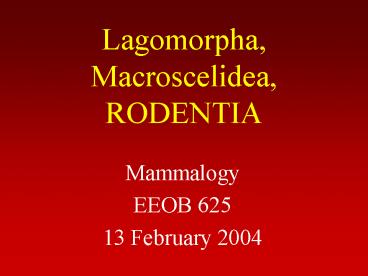Lagomorpha, Macroscelidea, RODENTIA - PowerPoint PPT Presentation
1 / 23
Title:
Lagomorpha, Macroscelidea, RODENTIA
Description:
Paramys, a squirrel-like ancestral genus from the Paleocene. Therapsid ... Sciuromorphous Primitive, squirrel-like masseter lateralis originates on ... – PowerPoint PPT presentation
Number of Views:287
Avg rating:3.0/5.0
Title: Lagomorpha, Macroscelidea, RODENTIA
1
Lagomorpha, Macroscelidea, RODENTIA
- Mammalogy
- EEOB 625
- 13 February 2004
2
Order Lagomoprpha
- Are lagomorphs closely related to Rodentia?
- similar cranial morphology adaptive zones
- - no consensus from molecular studies
(Vaughan) - Lagomorphs arose in Asia (Paleocene) underwent
radiation in N. America in Oligocene - Miocene - Comparisons with Rodentia
- incisors adaptations to herbivory I
2/1 vs. I 1/1 - - Jointed skull with diastema
fenestrated maxillary - cursorial adaptations
long hind legs (in Leporidae)
3
Order Lagomorpha 80 species
- Worldwide distribution except Australia
- Family Leporidae 11 genera, 54 species
- Competitive herbivores with derived
cursorial adaptations in diverse habitats around
the World - Family Ochotonidae 2 genera, 26 species
Smaller with sorter hind limbs and ears Nearctic
and Paleactic in mountainous habitats - Unusual nutritional strategy of hay making
4
Order Macroscelidea Elephant Shrews
- Family Macroscelididae 4 genera, 15 species
- Medium-sized, 50-500 g, in the Ethiopian since
the Miocene - Related to insectivores or elephants?
- Reduction of digits to 4 in pes, 3 (?) in pes
- Wide variety of habitats, feed on a variety of
invertebrates, mostly termites ants
5
Rodentia the gnawing victors
- About 43 of all mammals are rodents
- Criteria of success of a taxon __, ___, ___
- Why are rodents so successful? (Exam II)
- How do we approach such a question?
- Origin and Evolution Fossils from the late
Paleocene in Asia and North America - - Paramys, a squirrel-like ancestral genus from
the Paleocene
6
Paramys sp
Therapsid
Multituberculate
Feldhamer (1999)
7
Rodentia the gnawing victors
- How do we classify 2004 species, 443 genera, and
29 extant families? - Derived characters (Vaughan Table 18-1)
- Parallel evolution obscures relationships and
make classification to suborder difficult - A classification based on the infraorbital
foramen, masseter, zygomatic arch (Vaughan
18-2) - Sciuromorpha, Myomorpha, Hystricomorpha
8
Paramys sp
Cobert (1969)
9
Zygo-masseteric Patterns in Rodents
- Sciuromorphous Primitive, squirrel-like
masseter lateralis originates on rostrum and
zygomatic plate, infraorbital foramen, small - Myomorphous Derived, mouse-like medial
masseter originates on rostrum (maxillary)
passes through a slightly enlarged infraorbital
foramen. - Hystricomorphous Highly derived,
porcupine-like. Medial masseter originates on
rostrum and passes through a greatly enlarged
infraorbital Typical of several Neotropical
families
10
Medial masseter the infraorbital foramen of a
myomorph rodent
11
(No Transcript)
12
Rodent Dentition Mastication
- Is mastication the key to rodents success?
- Incisors enamel on labial surface only and
rootless for continuous growth - Diastema - a common gap in herbivores
- Molars premolars similar in appearance but
different in development. - Marvelous masticatory movements of the mandible
the elongated glenoid fossa and the moveable
mandibular symphysis
13
(No Transcript)
14
(No Transcript)
15
Heteromyidae
View from below glass of a foraging kangaroo rat
Seeds beads
16
The EndLagomorpha, Macroscelidea, RODENTIA I
17
(No Transcript)
18
(No Transcript)
19
(No Transcript)
20
(No Transcript)
21
(No Transcript)
22
Family Dipodidae
- Jerboas jumping mice (51 species)
- Nearctic, Palearctic, Ethiopian,
23
Dipodidae ( Zapodidae)
Zapus or Napaeozapus ?































